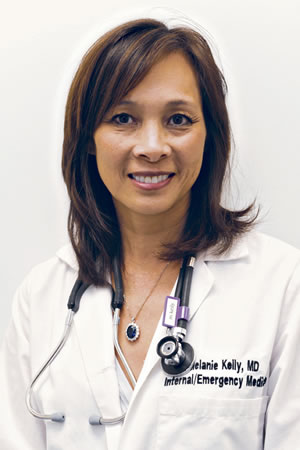Urgent Care At Your Service
Dr. Melanie Kelly
Medical director at Pearl City Urgent Care
Where did you receive your schooling and training?
I was born and raised here in Hawaii. I did my undergraduate studies at USC in California. Then I went to UC San Diego for medical school.
What’s your medical background leading up to the opening of Pearl City Urgent Care last November?
It goes back to the 1980s. I came back to Hawaii in 1986 and did my residency at UH. I’ve been practicing in the community ever since. My first job was in Waianae at the ER. I’ve worked in clinics and in ERs, and I’ve had private practices and a research company. While I was in the ERs, I realized that half of the patients that came in didn’t have a true emergency. They could go to a good urgent care facility or to private physicians’ offices.
Trang Lafitaga
What is the difference between going to the ER, Urgent Care or a regular physician?
Urgent Cares are not primary care practices. That’s a special function that belongs with pediatricians, internists and family practitioners, for example. We also don’t take care of life-threatening illnesses. People who have strokes, heart attacks or major injuries or traumas really belong at the emergency room. But there’s a whole gray area, so we can take care of people who are mildly to moderately ill. We can take care of fractures, moderately severe injuries, and then we fill in for primary care physicians by doing physicals, worker’s comp injuries and evaluations for disability. We are educating the community to help them understand when to go to the ER and when to go to urgent care. A brochure is available on our website: PearlCityUrgentcare.com.
Is Pearl City Urgent Care different than other urgent care facilities?
There are different levels of urgent care. Some have only physician extenders, like physician assistants or nurse practitioners. Some have X-rays, some don’t. We want to be the next level from an ER, so we do have intravenous fluids and medications which makes us very special; also we have emergency medicine-trained personnel and we have a full X-ray suite.
How big is your staff?
We have four physicians on staff that rotate. And we have two full-time nurse practitioners.
You opened just before Hawaii Medical Center closed. How has that impacted your patient intake?
We did not know the hospital would close. To the very last day I told people, “This place will never close. It would be impossibly hard for the community to close this,” but it did.
We knew that starting off we would have a slow ramp-up as people get used to the idea of our facility and recognize our location, but we thought we would be at maybe 30 patients a day by six months. We were already at that point in two and a half months. We’re really ramping up quickly, but we know we can handle up to 75 patients a day, so we’re not overcrowded. And we’re keeping the patients from having to wait very long.
Anything else you’d like to add?
We’ve been looking at urgent care facilities from a national and from a local point of view. A couple of years ago, I was watching a health reform debate and everybody was saying, you can fix this system but you can only have two of three things. You can either have more efficiency and higher quality, or lower costs. But you can’t have all three. And I was thinking why can’t you have all three? What is preventing us from going outside the box and making it truly better? That was in 2002. This debate has continued, and in the meantime Minute Clinics started on the Mainland. They were the initial urgent cares. If you look around the Mainland, they’re everywhere now. Minute Clinics was the first brand, and now there are many others. In major cities, there’s an urgent care in every community. What they’re designed to do is make medical care cheaper, faster and to maintain the high quality of care. That is going to be a huge answer to the overall healthcare problem. The Minute Clinic won an Innovation in Healthcare award because that idea was just perfectly timed. We feel that urgent cares will supplement the emergency care system as well as the primary care system. They’re both completely overburdened in Hawaii. I’m excited about this trend. The average patient going to the ER incurs costs of $850, and for the same condition, they go to an Urgent Care and the cost is $250. I think that’s better for everybody.
Hospital-based ERs have facility costs (what they incur as part of a large facility), they have to pay for personnel to staff for every situation round-the-clock, and they need to have CT equipment and technologists 24 hours a day, for example. We save in costs by scaling down to essential personnel and services, and being open during the highest demand times of the day and evening.







